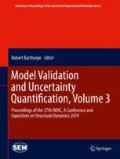Abstract
Vibration isolation is a common method used for minimizing the vibration of dynamic load-bearing structures in a region past the resonance frequency, when excited by disturbances. The vibration reduction mainly results from the tuning of stiffness and damping during the early design stage. High vibration reduction over a broad bandwidth can be achieved with additional and controlled forces, the active vibration isolation. In this context, “active” does not mean the common understanding that the surroundings are isolated against the machine vibrations. Also in this context, “passive” means that no additional and controlled force is present, other than the common understanding that the machine is isolated against the surroundings. For active vibration isolation, a signal processing chain and an actuator are included in the system. Typically, a controller is designed to enable a force of an actuator that reduces the system’s excitation response. In both passive and active vibration isolation, uncertainty is an issue for adequate tuning of stiffness and damping in early design stage. The two types of uncertainty investigated in this contribution are parametric uncertainty, i.e. the variation of model parameters resulting in the variation of the systems output, and model uncertainty, the uncertainty from discrepancies between model output and experimentally measured output. For this investigation, a simple one mass oscillator under displacement excitation is used to quantify the parameter and model uncertainty in passive and active vibration isolation. A linear mathematical model of the one mass oscillator is used to numerically simulate the transfer behavior for both passive and active vibration isolation, thus predicting the behavior of an experimental test rig of the one mass oscillator under displacement excitation. The models’ parameters that are assumed to be uncertain are mass and stiffness as well as damping for the passive vibration isolation and an additional gain factor for the velocity feedback control in case of active vibration isolation. Stochastic uncertainty is assumed for the parameter uncertainty when conducting a Monte Carlo Simulation to investigate the variation of the numerically simulated transfer functions. The experimental test rig enables purposefully adjustable insertion of parameter uncertainty in the assumed value range of the model parameters in order to validate the model. The discrepancy between model and system output results from model uncertainty and is quantified by the Area Validation Metric and an Bayesian model validation approach. The novelty of this contribution is the application of the Area Validation Metric and Bayes’ approach to evaluate and to compare the two different passive and active approaches for vibration isolation numerically and experimentally. Furthermore, both model validation approaches are compared.
Access this chapter
Tax calculation will be finalised at checkout
Purchases are for personal use only
References
VDI 2062: Vibration Insulation – Insulation Elements, Part 2. Verein Deutscher Ingenieure, Beuth Verlag, Berlin (2007)
VDI 2064: Aktive Schwingungsisolierung – Active Vibration Isolation. Verein Deutscher Ingenieure, Beuth Verlag, Berlin (2010)
Platz, R., Ondoua, S., Enss, G.C., Melz, T.: Approach to evaluate uncertainty in passive and active vibration reduction. In: SEM Society for Experimental Mechanics, 2014, Proceedings of the 32rd IMAC, pp. 345–352. Springer, Cham (2014)
Platz, R., Enss, G.C.: Comparison of uncertainty in passive and active vibration isolation. In: SEM Society for Experimental Mechanics, 2015, Proceedings of the 33rd IMAC, pp. 15–25 (2015)
Platz, R., Melzer, C.: Uncertainty quantification for decision making in early design phase for passive and active vibration isolation. In: Proceedings of ISMA 2016 Including ISMA Advance Conference Programme, pp. 4501–4513 (2016)
Roy, C.J., Oberkampf, W.L.: A complete framework for verification, validation, and uncertainty quantification in scientific computing (invited). In: 48th AIAA Aerospace Sciences Meeting Including the New Horizons Forum and Aerospace Exposition, p. 124 (2010)
Mallapur, S., Platz, R.: Quantification and evaluation of uncertainty in the mathematical modelling of a suspension strut using Bayesian model validation approach. In: SEM Society for Experimental Mechanics, 2017, Proceedings of the 35rd IMAC, pp. 113–124 (2017)
Sankararaman, S., Mahadevan, S.: Model validation under epistemic uncertainty. Reliab. Eng. Syst. Saf. 96, 1232–1241 (2011)
Kennedy, M., O’Hagan, A.: Predicting the output from a complex computer code when fas approximations are available. Biometrika 2000, 1–13 (2000)
Perfetto, S., Rohlfing, J., Infante, F., Mayer, D., Herold, S.: Test rig with active damping control for the simultaneous evaluation of vibration control and energy harvesting via piezoelectric transducers. J. Phys. Conf. Ser. 744, 012010 (2016)
Schuëller, G.I.: On the treatment of uncertainties in structural mechanics and analysis. Comput. Struct. 85, 235–243 (2007)
Siebertz, K., van Bebber, D., Hochkirchen, T.: Statistische Versuchsplanung: Design of Experiments (DoE). Springer, Berlin (2010)
Mallapur, S., Platz, R.: Uncertainty quantification in the mathematical modelling of a suspension strut using Bayesian inference. Mech. Syst. Signal Process. 118, 158–170 (2019)
Acknowledgements
The authors like to thank the German Research Foundation DFG for funding this research within the SFB 805.
Author information
Authors and Affiliations
Corresponding author
Editor information
Editors and Affiliations
Rights and permissions
Copyright information
© 2020 Society for Experimental Mechanics, Inc.
About this paper
Cite this paper
Lenz, J., Platz, R. (2020). Quantification and Evaluation of Parameter and Model Uncertainty for Passive and Active Vibration Isolation. In: Barthorpe, R. (eds) Model Validation and Uncertainty Quantification, Volume 3. Conference Proceedings of the Society for Experimental Mechanics Series. Springer, Cham. https://doi.org/10.1007/978-3-030-12075-7_14
Download citation
DOI: https://doi.org/10.1007/978-3-030-12075-7_14
Published:
Publisher Name: Springer, Cham
Print ISBN: 978-3-030-12074-0
Online ISBN: 978-3-030-12075-7
eBook Packages: EngineeringEngineering (R0)

